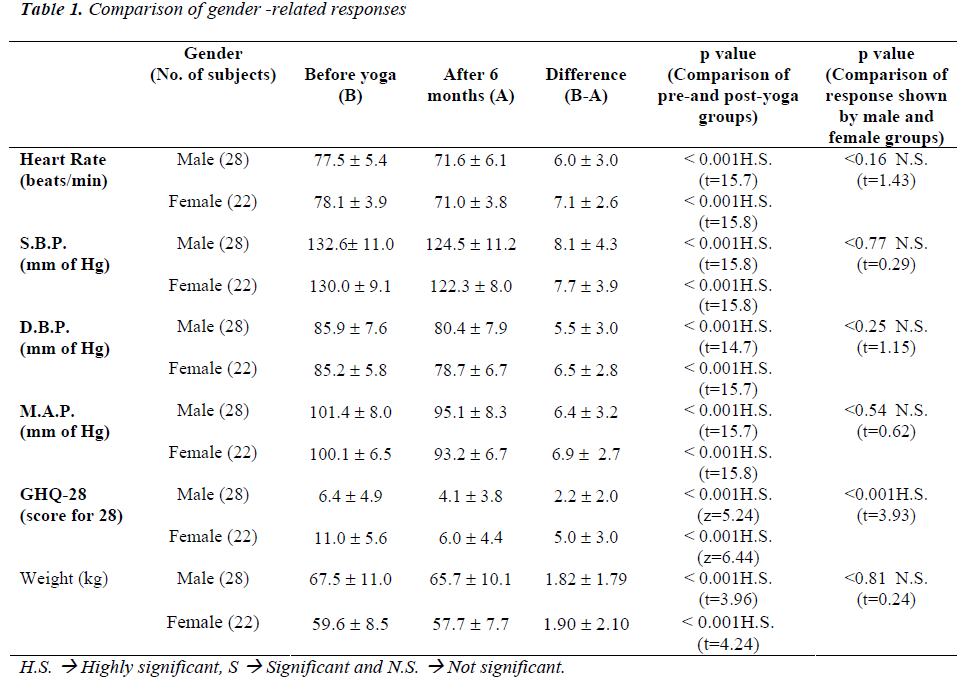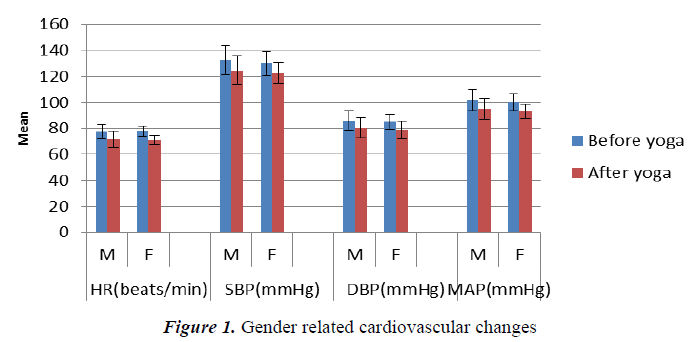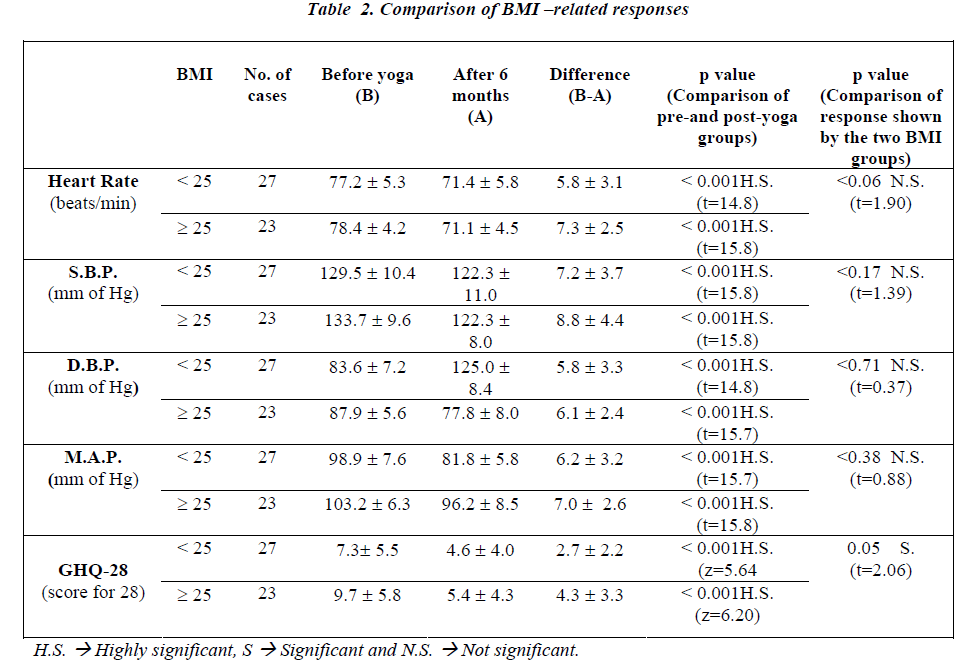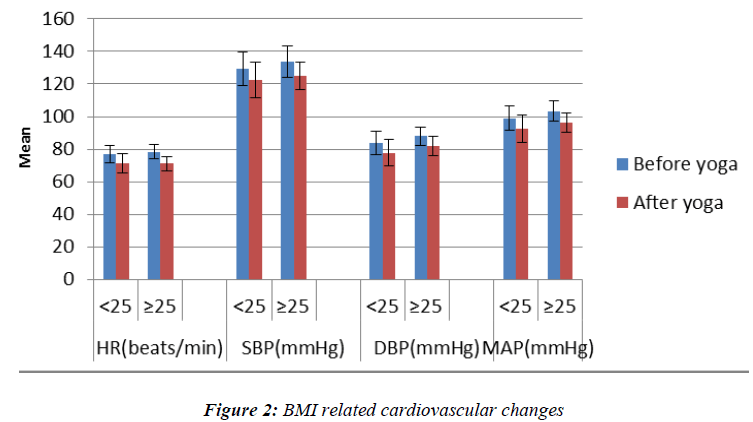ISSN: 0970-938X (Print) | 0976-1683 (Electronic)
Biomedical Research
An International Journal of Medical Sciences
- Biomedical Research (2011) Volume 22, Issue 4
Effect of body mass index and gender on the cardiovascular and mental response to yoga
Mental stress and cardiovascular diseases are becoming more common in the developing countries. One simpler, inexpensive method of overcoming this stress and the consequent cardiovascular complications is the practice of YOGA. Aim was to analyze the effect of yoga on cardiovascular and mental status in subjects above the age of 30 years, with respect to body mass index (BMI) and gender. This comparative study was done in 50 subjects, aged more than 30years, which included 28 male and 22 female, and 27 with BMI < 25 and 23 with BMI ? 25. The cardiovascular status was assessed by recording the blood pressure with a sphygmomanometer and heart rate was calculated from Lead II of electrocardio-gram. The mental status was evaluated with general health questionnaire 28 (GHQ-28). All the parameters were recorded before and once again after 6 months of regular yogic prac-tice. The mean decrease in the resting heart rate, diastolic blood pressure and GHQ-28 score, after 6 months of regular yoga practice, was more in females and in the group with BMI ? 25, whereas the mean decrease in the systolic blood pressure was equal in both gen-ders and more in the group with BMI ? 25. It can be concluded that yoga practice can be used as an intervention in ageing persons to reduce the morbidity and mortality from car-diovascular diseases, irrespective of age, gender and more so in subjects with BMI ? 25.
Keywords
Yoga, cardiovascular diseases, mental status, gender, body mass index.
Introduction
Mental stress and cardiovascular diseases are becoming more common in the developing countries. Early commencement of the cardiovascular changes due to the process of aging is being witnessed in the past few decades [1]. The reason is the increased stress and strain that we come across in our daily lives [2,3]. One simpler, in expensive method of overcoming this stress and the consequent cardiovascular complications is the practice of YOGA [2,3,4].
Review of literature reveals good number of papers on the effect of yoga on cardiovascular system, but most of them are pertaining to diseased conditions [2,3,4], where yoga is used in the treatment of the disease. Very few studies [5,6,7]have been done showing the preventive effects of yoga on the cardiovascular and mental status in normal subjects above the age of 30 years in whom the cardiovascular diseases and mental instability due to stress become more common. We could not find in literature a study which analyzed the effect of yoga on the basis of gender or body mass index. Analysis with respect to these parameters was chosen because the incidence of obesity is much on a rise. Hence, this study was undertaken to analyze the effects of yoga on cardiovascular and mental status in subjects above the age of 30 years, with respect to body mass index and gender, with a strong hope to reduce the incidence, early morbidity and mortality from the age-related cardiovascular changes.
Material and methods
This is a comparative study in which 50 normal healthy subjects above 30 years of age, who performed yoga regularly, were included in the study. Among them, 28 were males and 22 females. Out of these, 27 belonged to the group with BMI < 25 and 23, to the group with BMI ≥ 25. Ethical clearance was obtained from the institution. A written informed consent was obtained from each subject.
The health was assessed by history and clinical examination. The same subjects were chosen as both study and control group in order to minimize the confounding factors.
Weight (Kg), Height (cm), Body Mass Index [BMI] (Kg/m2), Heart Rate [HR] in beats/min, Blood Pressure [BP] in mmHg, and General Health Questionnaire (GHQ) – 28 score to assess mental status were all recorded after 30minutes of rest, before the start of yogic training.
The blood pressure was recorded with a mercury sphygmomanometer (Diamond), in supine position in the right upper limb by auscultatory method. Similarly, three readings were taken at an interval of 15 minutes each and an average of the three values calculated. The mean arterial pressure (MAP=DBP + 1/3 PP) was also calculated.
In the same resting condition, an electrocardiogram was recoded in Lead II (usingCARDIART 108T, J8A, 14901) and the average R-R interval of ten complexes was taken and the heart rate (HR=1500/ R-R interval) was calculated.
The mental status of each subject was assessed in a resting condition with the help of General Health Questionnaire (GHQ)-28 [8] in which the subject selects one answer from a set of four for each of the 28 questions. Depending on the answers, a score for each answer is given and the total score is calculated. A lesser score indicates subjective well-being and positive attitude; and a greater score indicates negative attitude of the individual.
All the subjects were given yogic training by a qualified yoga instructor for a period of 6 months for 1 hour daily between 6 a.m and 7 a.m. The schedule consisted of -
1. Warm-up exercises followed by shavasana (corpse pose) – 5 minutes.
2. Prayer (Suryanamaskara- salutation to the Sun) – 10 minutes.
3. Asanas (Postures) – 20 minutes.
4. Pranayama (rhythmic control of the breath) – 10 minutes.
5. Meditation – 10 minutes.
6. Shavasana (corpse pose) – 5 to 10 minutes.
The asanas [9,10,11] practised were:-
Vrikshasana (tree pose), Trikonasana (triangle pose), Hasthapadasana (hand to foot pose), Suryanamaskara (salutation to the Sun),Vajrasana (thunderbolt pose), Veerasana (warrior pose), Padmasana (lotus pose), Baddhakonasana (restrained angle pose), Shashankasana (rabbit pose), Parvatasana (mountain pose), Makarasana (crocodile pose), Bhujangasana (serpent pose), Dhanurasana (bow pose), PavanaMukthasana (air release pose), Matsyasana (fish pose), Sarvangasana (whole body pose), Halasana (plough pose), Chakrasana (wheel pose), Shavasana (corpse pose).
The different types of pranayamas [9,10,11] performed were:-
Surya Anuloma Viloma Pranayama (right nostril breathing), Chandra Anuloma Viloma Pranayama (left nostril breathing), Nadisuddhi Pranayama (alternate nostril breathing), Bhastrika Pranayama (bellows breathing).
The session was concluded by Rajayoga meditation [9,10,11] and finally shavasana.
The cardiovascular status of each subject, after 6 months of yoga practice, was assessed clinically in terms of blood pressure and heart rate recordings. The mean arterial pressure was again calculated. The mental status was also assessed again with the help of the same questionnaire and the scoring noted down. Statistical analysis was done by paired and unpaired‘t’ test and Wilcoxan’s signed rank test. Probability values, p< 0.05 were considered as statistically significant.
Results
The results obtained are expressed as mean ± standard deviation. The mean age of the subjects was 48.0 ± 11.1 years. Out of the 50 subjects, 28 were males and 22 females. 27 belonged to the group with BMI < 25 and 23, to the group with BMI ≥ 25. The mean height (cm) was 160.3 ± 9.3; the mean weight (kg) was 64.1 ± 10.7; the mean BMI (kg/m2) was 24.8 ± 3.3; and the mean BSA (m2) was 1.67 ± 0.17.
Heart Rate
After 6 months of regular yoga practice, in males (28 cases), the resting heart rate (beats/ min) reduced significantly from 77.5 ± 5.4 to 71.6 ± 6.1(p<0.001), and in females (22 cases) also, it lowered significantly from 78.1 ± 3.9 to 71.0 ± 3.8(p<0.001).But, the difference in response shown by the two sexes is not statistically significant, although a slightly more decrease is seen in female subjects (Table 1, Figure 1). The response was also evaluated on the basis of body mass index (BMI). In one group with BMI < 25 (27 cases), the resting heart rate reduced from 77.2 ± 5.3 to 71.4 ± 5.8(p<0.001); and in another group with BMI ≥ 25 (23 cases), it decreased from 78.4 ± 4.2 to 71.1 ± 4.5(p<0.001). Clinically there is more response seen in the second group but, it is not statistically significant (Table 2, Figure 2).
Systolic Blood Pressure
In males (28 cases), the resting systolic blood pressure (mm Hg) reduced from 132.6 ± 11.0 to 124.5 ± 11.2(p<0.001); and in females (22 cases), it decreased from 130.0 ± 9.1 to 122.3 ± 8.0(p<0.001). But, the difference in response shown by the two sexes is not significant (Table 1, Figure 1). The response was also evaluated on the basis of body mass index (BMI). In one group with BMI < 25 (27 cases), the resting systolic blood pressure reduced from 129.5 ± 10.4 to 122.3 ± 11.0 (p<0.001); and in another group with BMI ≥ 25 (23 cases), it decreased from 133.7 ± 9.6 to 125.0 ± 8.4(p<0.001). Although, there is more response in the second group clinically, the difference in response between the two groups is not statistically significant (Table 2, Figure 2).
Mean Arterial Pressure
In males (28 cases), the resting mean arterial pressure (mm Hg) reduced from 101.4 ± 8.0 to 95.1 ± 8.3 (p<0.001); and in females (22 cases), it decreased from 100.1 ± 6.5 to 93.2 ± 6.7(p<0.001). The difference in response shown by the two sexes is not significant statistically, although a slightly more decrease is seen in female subjects (Table 1, Figure 1). The response was also evaluated on the basis of body mass index (BMI). In one group with BMI < 25 (27 cases), the resting mean arterial pressure reduced from 98.9 ± 7.6 to 92.6 ± 8.5(p<0.001); and in another group with BMI ≥ 25 (23 cases), it decreased from 103.2 ± 6.3 to 96.2 ± 6.1(p<0.001). Although, there is greater response in the second group clinically, the difference in response between the two groups is not statistically significant (Table 2, Figure 2).
Diastolic Blood Pressure
In males (28 cases), the resting diastolic blood pressure (mm Hg) reduced from 85.9 ± 7.6 to 80.4 ± 7.9(p<0.001); and in females (22 cases), it decreased from 85.2 ± 5.8 to 78.7 ± 6.7(p<0.001). The difference in response shown by the two sexes is not statitically significant although a slightly more decrease is seen in female subjects (Table 1, Figure 1). The response was also evaluated on the basis of body mass index (BMI). In one group with BMI < 25 (27 cases), the resting diastolic blood pressure reduced from 83.6 ± 7.2 to 77.8 ± 8.0(p<0.001); and in another group with BMI ≥ 25 (23 cases), it decreased from 87.9 ± 5.6 to 81.8 ± 5.8 (p< 0.001). Although there is more response in the second group clinically, the difference in response between the two groups is not statistically significant (Table 2, Figure 2).
Mental Status
The mental status was analyzed with the help of a questionnaire (GHQ-28) and the total score noted down. Lesser score indicates positive attitude and greater score indicates negative attitude of the individual towards life and more susceptibility of the individual to psychiatric/psychosomatic disorders.
In males (28 cases), the GHQ-28 score reduced from 6.4 ± 4.9 to 4.1 ± 3.8(p<0.001); and in females (22 cases), it reduced from 11.0 ± 5.6 to 6.0 ± 4.4(p<0.001). The difference in response shown by the two sexes is highly significant (p<0.001), the response being better in females (Table 1).
The response was also evaluated on the basis of body mass index (BMI). In one group with BMI < 25 (27 cases), the GHQ score reduced from 7.3 ± 5.5 to 4.6 ± 4.0(p<0.001); and in another group with BMI ≥ 25 (23 cases), it decreased from 9.7 ± 5.8 to 5.4 ± 4.3(p<0.001). The difference in response shown by these two groups is significant (p=0.05), the response being better in subjects with BMI ≥ 25 (Table 2).
Weight
In males (28 cases), the weight (Kg) reduced from 67.5 ± 11.0 to 65.7 ± 10.1(p<0.001); and in females (22 cases), it decreased from 59.6 ± 8.5 to 57.7 ± 7.7(p<0.001). The difference in response shown by the two sexes is not significant (Table 1).
Discussion
In the present comparative study, it was found that there was a highly significant reduction in the resting heart rate, systolic, diastolic, and mean arterial blood pressures after 6 months of yogic practice; and also a highly significant improvement in the mental status of the subject.
Voluntary control of autonomic functions of a yogi in the form of stoppage of his heart beat was reported by Kothari et al [12]. Significant reduction in resting heart rate after yogic practice was observed in normal subjects [5,13]. Similar reductions in heart rate after yoga training were recorded in hypertensive patients [14,15]; in bronchial asthma patients [16] and in diabetic patients [17].
Similar to the present study, a significant reduction in the systolic, diastolic and mean arterial pressures were previously reported in normal healthy subjects [5,13]; in hypertensive patients [14,15]; in bronchial asthma patients [16]; and in diabetic patients [17].
Decrease in heart rate and blood pressure in subjects practising yoga indicates predominance of the parasympathetic system and relatively reduced sympathetic tone [13,18]. This may be due to the conditioning effects of yoga on autonomic functions and mediated through the limbic system and higher areas of central nervous system [5]. Regular practice of yoga increases the baroreflex sensitivity and decreases the sympathetic tone thereby restoring blood pressure to normal level in patients of essential hypertension [7]. Pranayama decreases basal sympathetic tone and increases basal parasympathetic activity [6]. Meditation reduces stressinduced sympathetic overactivity resulting in decreased diastolic blood pressure and heart rate [18], which ensures better peripheral circulation [19] and blood flow to tissues. Shavasana alters the proprioceptive and exteroceptive influences to the hypothalamus, which reduces the sympathetic activity and hence a decrease in basal heart rate and blood pressure is seen [20].
There is a significant better response in subjects with BMI of > 25. This may suggest that yoga is more effective in reducing the basal heart rate and blood pressure in morbid conditions like obesity. There is an equal response in heart rate and blood pressure reduction, statistically, in both males and females, although a slightly more decrease is seen in female subjects.
A highly significant improvement in the mental status was seen after 6 months of yogic practice as evident by a reduction in GHQ-28 scoring. Similar improvement in the mental status, especially decreased anxiety during stress, was observed in normal subjects [21,22]. Regular yoga practice, done by patients suffering from psychological disorders, brought about a significant improvement in their mental health [23]. There was also an improvement in subjective well-being, quality of life and decreased anxiety after yoga in hypertensive and ischemic heart disease patients [24]. Environmental conditions and variety of behavioural factors such as stress, anxiety, affective and attitudinal dispositions of the individual, influence the cardiovascular responses. Yogic exercise involves physical, mental and spiritual task in a comprehensive manner, bringing about behavioural changes [7]. Static postures of yogasanas and controlled rhythmic breathing of pranayamas involve minimal bodily movements and result in maximal physical and mental relaxation. The proprioceptive involvement in a well coordinated fashion with mentally relaxed state in the yogic practices helped the subjects to achieve the improvement of psychological and psychomotor components. The improvement in physiological and psychological functions, improved the feeling of subjective mental well-being [22]. Stress is known to modulate the activity of autonomic nervous system and central nervous system in a way, so as to cope with stress to get adapted to it. In stressful states with preponderance of sympathetic activity, yogic asanas and pranayama can lead to a state of reduced sympathetic activity shifting the autonomic balance towards relative parasympathetic dominance [5,13,18].
A better response in mental status is seen in female subjects and in subjects with BMI > 25 (insignificant).
The present study also revealed a highly significant reduction in weight after 6 months of yoga. Similar findings were reported by Udupa et al [21].
Most of the studies conducted so far have generalized their results irrespective of age, gender or weight of the subjects. Very few studies have been conducted on subjects above 30 years of age in which age group, cardiovascular diseases are more prevalent. In the present study, an attempt was made to fill up these lacunae. The response to 6 months of yoga practice was assessed with respect to age, gender and body mass index.
Although the subjects were instructed not to change their lifestyles, diet and exercise patterns, but over a period of 6 months, this could have changed to a certain extent and these could be the confounding factors in the study. It can be concluded that yoga practice can be used as an intervention in ageing persons to reduce the morbidity and mortality from cardiovascular diseases, irrespective of age, gender and more so in subjects with BMI ≥ 25.
References
- Shah SN. API Textbook of Medicine. 7th ed. Mumbai: The Association of Physicians of India; 2003: 432-433.
- Nagarathna R, Nagendra HR. Yoga for hypertension and heart diseases. 1st ed. Bangalore: Swami Vivekananda Yoga Prakashana; 2003.
- Swami Satyananda Saraswati. Yoga and cardiovascular management. 2nd ed. Munger: Yoga Publications Trust; 2001.
- Swami Shankardevananda. The effects of yoga on hypertension. 2nd ed. Munger: Bihar School of Yoga; 1998.
- Selvamurthy W, Nayar HS, Joseph NT, Joseph S. Physiological effects of yogic practice. Nimhans Journal 1983; 1 (1): 71-80.
- Udupa K, Madanmohan, Bhavanani AB, Vijayalakshmi P, Krishnamurthy N. Effect of pranayam training on cardiac function in normal young volunteers. Indian J PhysiolPharmacol 2003; 47 (1): 27-33.
- Bharshankar JR, Bharshankar RN, Deshpande VN, Kaore SB, Gosavi GB. Effect of yoga on cardiovascular system in subjects above 40 years. Indian J Physiol-Pharmacol 2003; 47 (2): 202-206.
- Goldberg D. Manual of the General Health Questionnaire. Windsor: NFER Publishing Company; 1978.
- Bijlani RL. Understanding Medical Physiology. 3rded. New Delhi: Jaypee Brothers; 2004: 871-910.
- Iyengar BKS. Light on yoga. 7thed. New Delhi: Harpercollins Publishers; 2002.
- Ray SD. Yogic exercises-Physiologic and Psychic Processes. 1sted. New Delhi: Jaypee Brothers; 2001.
- Kothari LK, Bordia A, Gupta OP. The yogic claim of voluntary control over the heart beat: an unusual demonstration. Am Heart J 1973; 86 (2): 282-284.
- Joseph S, Sridharan K, Patel SKB, Kumaria M L, Sel-vamurthy W, Joseph NT et al. Study of some physiological and biochemical parameters in subjects under-going yogic training. Indian J Med Res 1981; 74: 120-124.
- Murugesan R, Govindarajulu N, Bera TK. Effect of selected yogic practices on the management of hypertension. Indian J PhysiolPharmacol 2000; 44 (2): 207-210.
- Vijayalakshmi P, Madanmohan, Bhavanani AB, Patil A, Kumar Babu P. Modulation of stress induced by isometric handgrip test in hypertensive patients following yogic relaxation training. Indian J Physiol Pharmacol 2004; 48 (1): 59-64.
- Khanam AA, Sachdeva U, Guleria R, Deepak KK. Study of pulmonary and autonomic functions of asthma patients after yoga training. Indian J Physiol Pharmacol 1996; 40 (4): 318-324.
- Singh S, Malhotra V, Singh KP, Madhu SV, Tandon OP. Role of yoga in modifying certain cardiovascular functions in type 2 diabetic patients. J Ass Phys Ind 2004; 52: 203-206.
- Anand BK. Yoga and medical sciences. Indian J Physiol Pharmac 1991; 35 (2): 84-87.
- Bhargava R, Gogate MG and Mascarenhas JF. Autonomic responses to breath holding and its variations following pranayama. Ind J PhysiolPharmac 1988; 32 (4): 257-264.
- Bera TK, Gore MM, Oak JP. Recovery from stress in two different postures and in shavasana-A yogic relaxation posture. Indian J PhysiolPharmacol 1998; 42 (4): 473-478.
- Udupa KN, Singh RH. The scientific basis of yoga. J Am Med Ass 1972; 220 (10): 1365.
- Ray US, Mukhopadhyaya S, Purkayastha SS, Asnani V, Tomer OS, Prashad R et al. Effect of yogic exercises on physical and mental health of young fellowship course trainees. Indian J Physiol Pharmacol 2001; 45 (1): 37-53.
- Sethi BB, Trivedi JK, Srivastava A, Yadav S. Indigenous therapy in practice of psychiatry in India. Indian J Psychiat 1982; 24 (3): 230-236.
- Damodaran A, Malathi A, Patil N, Shah N, Suryavan-shi, Marathe S. Therapeutic potential of yoga practices in modifying cardiovascular risk profile in middle aged men and women. J Ass Phys Ind 2002; 50: 633-640.



